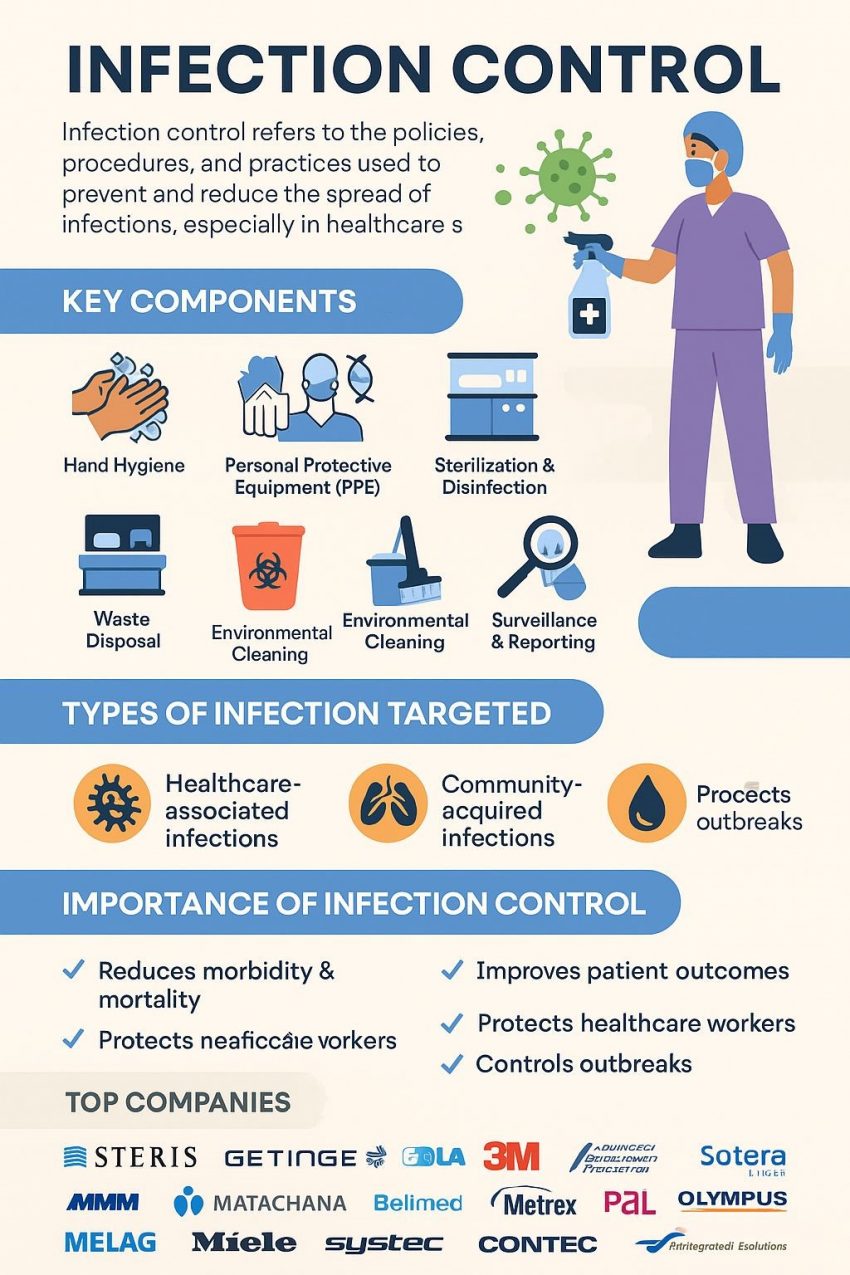Infection control has always been a critical part of healthcare. The ongoing pandemic has highlighted the importance of stringent infection control measures, not only in healthcare settings but also in the general community. The European infection control market has seen significant growth as a result, with innovations in products, technologies, and services aimed at mitigating the spread of infections.
The Growing Demand for Infection Control Products in Europe
The need for infection control products in Europe is propelled by several factors, including:
-
Increasing Healthcare-Associated Infections (HAIs): Healthcare-associated infections remain a primary concern in European hospitals. According to the European Centre for Disease Prevention and Control (ECDC), over 4 million patients suffer from healthcare-associated infections each year, contributing to longer hospital stays, additional treatments, and increased healthcare costs.
-
Rising Awareness of Infection Prevention: The COVID-19 pandemic has greatly increased awareness of the need for infection control not only in hospitals but in all public and private settings, including schools, workplaces, and retail spaces.
-
Technological Advancements: The rapid development of antimicrobial materials, sterilization equipment, and infection control software solutions has created new opportunities for improving infection prevention.
-
Stricter Regulatory Standards: The European Union (EU) and national governments are enforcing stricter guidelines and regulations on infection control practices in healthcare settings. The EU has implemented the European Medical Device Regulation (MDR) to ensure the safety of infection control products, particularly in hospitals.
Market Segmentation: Key Areas of Growth
The European infection control market can be segmented into various product categories:
-
Personal Protective Equipment (PPE): This includes face masks, gloves, gowns, and eye protection. The demand for PPE surged during the pandemic and continues to be strong, especially as many healthcare facilities require these products to prevent cross-contamination.
-
Sterilization Equipment: Sterilization methods such as autoclaving, chemical sterilization, and UV radiation are essential in maintaining a sterile environment in hospitals and clinics. Technological advancements in these sterilization techniques are pushing market growth.
-
Infection Control Consumables: These include disinfectants, wipes, sanitizers, and other consumables used in cleaning and disinfecting surfaces, medical instruments, and patient care areas. Hospitals and healthcare facilities are increasingly using advanced disinfectants that are more effective and environmentally friendly.
-
Air Filtration Systems and UV Light Technology: With growing concerns over airborne infections, particularly in the context of respiratory diseases, the demand for high-efficiency particulate air (HEPA) filters and UV-C light sterilization devices has skyrocketed. Hospitals and care homes have seen a rise in investments in air filtration systems to prevent the spread of viruses and bacteria.
-
Infection Control Software: Automation and software solutions that track, manage, and report infection control activities are also gaining ground in the European market. These technologies enable healthcare providers to enhance infection prevention strategies by analyzing real-time data.
Key Market Drivers in Europe
-
The COVID-19 Pandemic: The pandemic dramatically reshaped the infection control market in Europe, emphasizing the need for better protection, surveillance, and sterilization practices. Though the immediate crisis is waning, the increased focus on infection control in all sectors continues to drive the market.
-
Aging Population: Europe’s aging population is another contributing factor. Older adults are more susceptible to infections and are likely to need healthcare services that require robust infection control measures.
-
Hospitals and Healthcare Facilities Expansion: The ongoing expansion of hospitals and healthcare infrastructures across Europe, particularly in countries like Germany, France, and the UK, requires more infection control products and services.
-
Rising Awareness of Antimicrobial Resistance (AMR): The rise in antimicrobial resistance is driving the demand for products and solutions that prevent the spread of resistant bacteria, such as advanced disinfectants and antimicrobial coatings for medical devices.
Challenges in the European Infection Control Market
Despite the growth and positive outlook, there are several challenges facing the infection control market in Europe:
-
Regulatory Compliance: The infection control industry is subject to stringent regulatory requirements. Products such as sterilizers and disinfectants must meet European standards, and companies must invest in compliance measures to ensure that their products can be marketed within the EU.
-
Supply Chain Disruptions: The global supply chain disruptions caused by the COVID-19 pandemic exposed vulnerabilities in the procurement of infection control products. Issues such as delays, shortages, and price inflation of key components continue to affect the market.
-
Cost Concerns in Healthcare Systems: As the demand for infection control products grows, so do the associated costs. Hospitals and healthcare facilities must balance the need for high-quality infection control solutions with tight budgets.
-
Sustainability: There is increasing pressure for infection control products to be sustainable. With the growing environmental impact of disposable PPE and single-use products, there is an increasing call for eco-friendly alternatives and more sustainable manufacturing processes.
The Future of the European Infection Control Market
The future of the European infection control market looks promising, driven by advancements in technology, increased investments in healthcare infrastructure, and growing awareness of the importance of infection prevention. Innovations in antimicrobial materials, infection control software, and sterilization technologies are expected to further transform the market.
With healthcare systems across Europe focusing on reducing healthcare-associated infections and improving patient safety, the demand for infection control products and services will remain strong. As new challenges emerge, including the threat of new infectious diseases, the market will continue to evolve with an emphasis on more advanced, efficient, and sustainable solutions.
Conclusion
The European infection control market is at a crossroads, driven by the lessons learned from the COVID-19 pandemic and the ongoing need to protect both patients and healthcare workers from the spread of infections. With technological advancements and increasing investments in healthcare infrastructure, the market is set to continue its growth trajectory. Companies that innovate and adapt to the evolving demands of the healthcare system will be poised to thrive in this expanding market.

